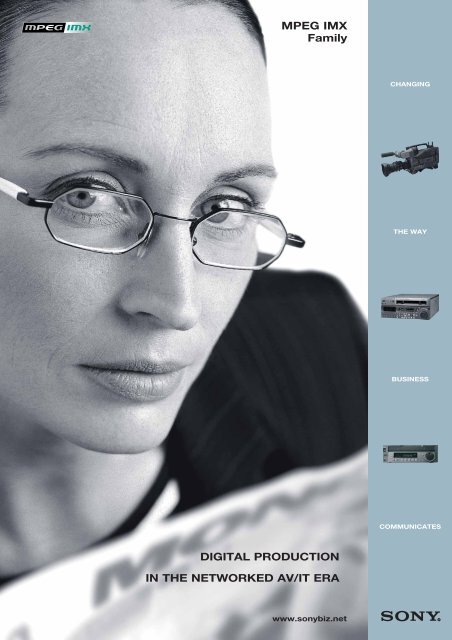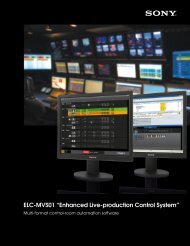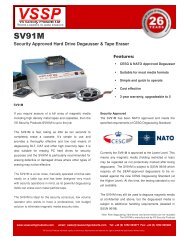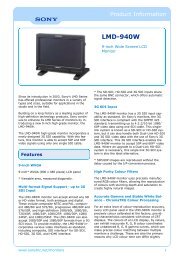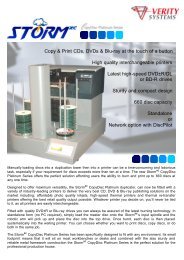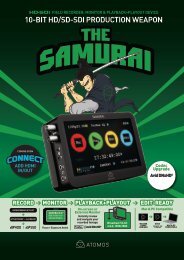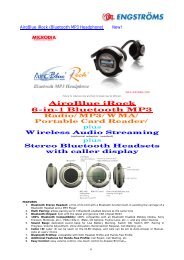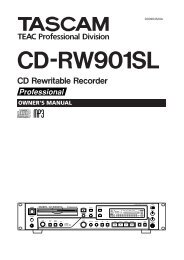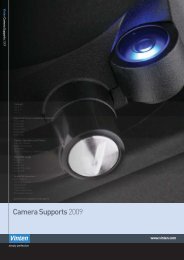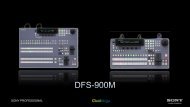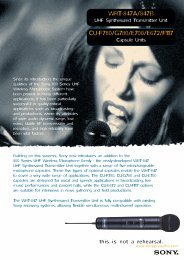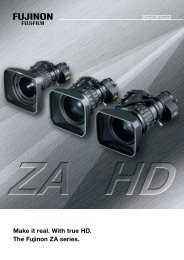DIGITAL PRODUCTION IN THE NETWORKED AV/IT ERA MPEG ...
DIGITAL PRODUCTION IN THE NETWORKED AV/IT ERA MPEG ...
DIGITAL PRODUCTION IN THE NETWORKED AV/IT ERA MPEG ...
Create successful ePaper yourself
Turn your PDF publications into a flip-book with our unique Google optimized e-Paper software.
<strong>MPEG</strong> IMXFamilyCHANG<strong>IN</strong>G<strong>THE</strong> WAYBUS<strong>IN</strong>ESSCOMMUNICATES<strong>DIG<strong>IT</strong>AL</strong> <strong>PRODUCTION</strong><strong>IN</strong> <strong>THE</strong> <strong>NETWORKED</strong> <strong>AV</strong>/<strong>IT</strong> <strong>ERA</strong>www.sonybiz.net
<strong>DIG<strong>IT</strong>AL</strong> <strong>PRODUCTION</strong><strong>IN</strong> <strong>THE</strong> <strong>NETWORKED</strong> <strong>AV</strong>/<strong>IT</strong> <strong>ERA</strong>CONTENTSAN <strong>IN</strong>TRODUCTION TO <strong>MPEG</strong> IMXAN <strong>IN</strong>TRODUCTION TO <strong>MPEG</strong> IMX . . . . . . . . . . . . . 2<strong>MPEG</strong> IMX TECHNOLOGY . . . . . . . . . . . . . . . . . . . . . 4<strong>MPEG</strong> IMX <strong>IN</strong> ACTION . . . . . . . . . . . . . . . . . . . . . . . 6PRODUCT L<strong>IN</strong>E-UPCAMCORDER . . . . . . . . . . . . . . . . . . . . . . . . . . . . . . . 8MSW-900P . . . . . . . . . . . . . . . . . . . . . . . . . . . . . . . . . 8CAMCORDER ACCESSORIES . . . . . . . . . . . . . . . . . . . 9STUDIO RECORDERS . . . . . . . . . . . . . . . . . . . . . . . 10MSW-M2000P/1 . . . . . . . . . . . . . . . . . . . . . . . . . . . . 10MSW-A2000P/1 . . . . . . . . . . . . . . . . . . . . . . . . . . . . . 10MSW-2000 . . . . . . . . . . . . . . . . . . . . . . . . . . . . . . . . 11STUDIO PLAYER . . . . . . . . . . . . . . . . . . . . . . . . . . . 11MSW-M2100P/1 . . . . . . . . . . . . . . . . . . . . . . . . . . . . 11STUDIO RECORDER/PLAYER ACCESSORIES . . . 12e-VTR NETWORK <strong>IN</strong>TERFACE OPTION . . . . . . . . . . . 12COMPACT PLAYERS . . . . . . . . . . . . . . . . . . . . . . . . 13J-3/A AND J-3/SDI . . . . . . . . . . . . . . . . . . . . . . . . . . 13SPECIFICATIONS . . . . . . . . . . . . . . . . . . . . . . . . . . . 14It has never been more important to increase theefficiency of programme production. But for prestigiousbroadcast productions, improving efficiency alone is notenough. Programme quality must be maintained and thechallenge of distributing content across multiple deliveryplatforms must also be met. Choosing production systemswhich meet business needs today, and future-proof anoperation for business tomorrow, is a critical decision foreveryone.<strong>MPEG</strong> IMX camcorders, studio recorders and players havebeen designed from the ground up to meet thesedemands. Building on over 25 years of Sony designexperience, <strong>MPEG</strong> IMX is already meeting the needs ofbroadcasters and production facilities around the world.Users have entrusted the production of sports, drama,arts, commercials, news and natural history programmesto <strong>MPEG</strong> IMX, as well as distribution and long termarchiveof content.<strong>MPEG</strong> IMX provides the combination of excellent pictureand sound quality, class-leading editing performance andrugged reliability which is mandatory for today’s operations.And to guarantee continued revenue from existing tapelibraries, <strong>MPEG</strong> IMX recorders and players providecompatible replay of Betacam, Betacam SP, Betacam SX,<strong>MPEG</strong> IMX and Digital Betacam cassettes.2
Adherence to the recognised SMPTE D-10 recordingstandard is at the heart of the <strong>MPEG</strong> IMX design philosophy.This guarantees seamless operation with D-10-compliantsystems from a wide range of manufacturers, allowingusers to mix and match products from many suppliers.And the line-up of <strong>MPEG</strong> IMX products continues to grow.For 2003, Sony has introduced the revolutionary e-VTR –a fully networked <strong>MPEG</strong> IMX recorder with IP connectivity.Incorporating the latest advances in file transfer andmetadata, e-VTR elegantly integrates <strong>AV</strong> and <strong>IT</strong> operationand opens up the possibilities for collaborative contentproduction within networked workgroups.From standalone <strong>MPEG</strong> IMX camcorders and studiorecorders, to fully networked production systems forinternational broadcasting, <strong>MPEG</strong> IMX provides the idealplatform for the digital-networked era.For more information, please visit the <strong>MPEG</strong> IMX website:www.sonybiz.net/imx3
<strong>MPEG</strong> IMX FAMILY<strong>THE</strong> <strong>MPEG</strong> IMX SYSTEMTECHNOLOGY BUILT ON OPEN STANDARDS<strong>MPEG</strong> IMX incorporates the latest advances inproduction technology and is designed to fullymeet recognised industry standards. Technologiesare only incorporated where they providedemonstrable new benefits to the end user. Someof the latest technologies to be incorporated intothe <strong>MPEG</strong> IMX system are explained here.Broadcast Quality Pictures with D-10 OperationThe Society of Motion Picture and Television Engineers(SMPTE) has issued two standards on which <strong>MPEG</strong>IMX is based. These standards, known as D-10, wereissued to ensure seamless operation between productsfrom multiple manufacturers, including inter-operabilitywith the Sony XPRI non-linear editing system and withthe Sony Professional Disc system.The first D-10 standard, SMPTE 356M, describes an<strong>MPEG</strong>-2 4:2:2P@ML data stream employing Intraframe(I-frame) compressed video encoding. SMPTE356M provides for recording at 50 Mb/s for the highestquality Standard Definition video performance andmulti-generation editing.The second SMPTE D-10 standard is SMPTE 365M.This describes all aspects of the physical recordingwithin a tape-based recorder. It contains details of therecorded data tracks on tape and the dimensions of thecassette. <strong>MPEG</strong> IMX camcorders, studio recorders andplayers conform to the two D-10 standards.Eight Channels of Digital AudioSelected devices within the <strong>MPEG</strong> IMX product line-upcan record and playback eight channels of 48kHzdigital audio at 16-bit resolution. <strong>MPEG</strong> IMX studiorecorders and players can also be switched to fourchannel operation at 24-bit 48kHz via a user selectableset-up menu.Longest-Ever Recording Times<strong>MPEG</strong> IMX provides the longest-ever long recordingtime on a 1 ⁄2-inch Betacam-family cassette. A maximumof 220 minutes can be stored on a large cassette and 71minutes on a small cassette when recording in 625/50mode.Lossless Transfer of <strong>MPEG</strong>-2 DataThe Serial Data Transport Interface – Content Package(SDTI-CP) is another SMPTE standard employed within<strong>MPEG</strong> IMX. SDTI-CP is an interface that transportsthe D-10 <strong>MPEG</strong> IMX data from one device to another.It transfers the data in its native D-10 form, guaranteeing aperfect data copy from one D-10 device to the next. <strong>MPEG</strong>IMX studio recorders use SDTI-CP to transfer video andaudio from <strong>MPEG</strong> IMX cassettes at up to twice normalspeed to D-10-compliant disk recorders and servers.Compatibility with Betacam, Betacam SP,Betacam SX and Digital Betacam<strong>MPEG</strong> IMX maintains compatibility with currentanalogue and digital systems. This compatibilityprovides a logical, cost-effective migration path to acombined <strong>AV</strong>/<strong>IT</strong> operation.Metadata EnabledRapid access to content is critical when producing,repurposing and distributing content across multipleplatforms. SMPTE has standardised the Unique MaterialIdentifier (UMID) to radically improve the searching forand access to material. The UMID provides a uniquelabel for each item of video and audio and canbe tracked throughout the production chain. The UMIDcan link video and audio material on tape or disk toproduction notes, scripts and viewer information heldwithin an external database. This fully integrates allaspects of content production.File-Based Operation using MXFThere is a continuing shift from traditional step-by-stepprogramme production to workgroup-based productionacross computer networks. The increased speed ofnetworks and the availability of lower cost <strong>IT</strong> componentscontinue to accelerate the rate of this change.But workgroup operation can only succeed when standardisedformats exist for the file-based exchange ofvideo and audio material. The Professional <strong>MPEG</strong>Forum recognised this need, and worked to create MXF(the Material Exchange Format).MXF is a file exchange mechanism for the movementof video, audio and metadata across a network. MXFhas been developed for storage on a variety of media,and operates independently of any specific network oroperating system. MXF is compression independentand can carry many different content types as its payload,including <strong>MPEG</strong> IMX, HDCAM, DVCAM, DVCPROand uncompressed video.MXF has been designed to be fully expandable forfuture applications, and provides an extremely comprehensivemetadata capability. MXF is an open, widelysupported and clearly documented file format that isused in products such as the <strong>MPEG</strong> IMX-based e-VTRwhere traditional stream-based <strong>AV</strong> production canco-exist within file-based operations.Fully Networkable for Combined <strong>AV</strong>/<strong>IT</strong> OperationMXF can transfer <strong>MPEG</strong> IMX video, audio and metadatabetween devices as computer files. Gigabit Ethernetinterfaces are being added to products within the<strong>MPEG</strong> IMX line-up to facilitate efficient exchange ofthese files. In addition to a number of <strong>MPEG</strong> IMX diskbaseddevices, a Gigabit Ethernet interface can now beadded to an <strong>MPEG</strong> IMX VTR to provide e-VTR operationusing TCP/IP and File Transfer Protocol (FTP).4
<strong>THE</strong> <strong>MPEG</strong> IMX SYSTEM<strong>MPEG</strong> IMX RECORD<strong>IN</strong>G FORMATGEN<strong>ERA</strong>LTape width12.65 mm ( 1 ⁄2-inch)Tape materialMetal Particle tapeRecording/ Max. 184 (525) / 220 (625)Playback timewith L cassetteTape speed64.467 (525) / 53.776 (625) mm/sTrack pitch 21.7 µmTracks per frame8 tracks/frameLongitudinal tracksTime code/ControlPlayback compatibilityMSW-M2000P/1 +Betacam, Betacam SP, Betacam SX,MSW-M2100P/1Digital BetacamMSW-A2000P/1Betacam, Betacam SP, Betacam SXMSW-2000Betacam SXVIDEOCompression<strong>MPEG</strong>-2 4:2:2P@ML, Intra framecoding (ISO/IEC 13818-2000)Video bit rate50 Mb/sActive lines per frame 512 (525)/608 (625)Sampling frequencyY: 13.5 MHz, R-Y/B-Y: 6.75 MHzQuantization8 bits/sampleError correctionReed-SolomonAUDIOCompressionNoneSampling frequency48 kHzQuantization16 or 24 bits/sample (selectable)Channels 8 or 4Data recording capability YesError correctionReed-Solomon<strong>MPEG</strong> IMX Advantages• <strong>MPEG</strong>-2 4:2:2P@ML at 50 Mb/s• Superb picture quality• 608 (625/50) lines per frame• 220 minutes recording withL-cassette• 8 channels of digital audio• Frame accurate digital editing• Lower tape running costs• Lower maintenance costs• Powerful editing features includingpre-read• Fully networkable for IP operation• Metadata-enabled• Based on industry standardsthroughout• Rugged and reliableThis network capability emphasises how <strong>MPEG</strong> IMXcan safeguard today’s productions for whatever thefuture may bring.Rapid Access to Recorded Materialusing the Tele-File SystemTele-File is a system for identifying the location of videoand audio content on a cassette. The system is basedupon the Tele-File cassette label. This label hasa built-in memory chip and can be attached to anyBetacam-family cassette. Information, such as the<strong>IN</strong> point, the OUT point and the NAME of a video clip,can be written to and read from a Tele-File label usinga suitable Tele-File Reader/Writer.<strong>MPEG</strong> IMX studio recorders, players, camcordersand the revolutionary e-VTR have a Tele-Filereader/writer built in to the cassette compartment.This allows a networked e-VTR to rapidly identifyand cue up to video files recorded on the tape. WithTele-File, a controlling software application can lookat the files in the same way as if it were looking at a listof files on a computer hard disk. This significantlyreduces the time required to access material, leadingto greater operation efficiency and improved workflow.5
<strong>MPEG</strong> IMX FAMILY<strong>MPEG</strong> IMX <strong>IN</strong> ACTIONSHOOT<strong>IN</strong>G W<strong>IT</strong>H CONFIDENCESHOPP<strong>IN</strong>G W<strong>IT</strong>H <strong>MPEG</strong> IMXQuality considerations are important in the Austrianbroadcast market. It was the superior image and soundquality offered by <strong>MPEG</strong> IMX that motivated ORF tobecome an early adopter of the format, and also assistedin the development of the first Sony <strong>MPEG</strong> IMXcamcorder.ORF made the strategic decision to adopt <strong>MPEG</strong>IMX as its preferred production format in April 2000.At that time, the MSW-900P camcorder was still inprototype form. What followed was a period of intensivedevelopment co-operation between the twoorganisations to bring the camcorder’s performancecharacteristics in line with ORF’s requirements.The MSW-900P is widescreen switchable and offersenhanced picture quality and multi-generation performancefor those broadcasters that have requesteda 50 Mb/s solution. It features an extensive set-upmenu with an ability to save all the individual parametersettings to Memory Stick, the revolutionary IC Recordingmedia developed by Sony. This allows a cameramanto pick up the camcorder and install his preferredsettings in a matter of seconds.Another operator-focused feature of the MSW-900Pis a ‘loop recording’ feature. This captures sound andpicture for an eight-second period before the recordbutton is pushed and retains this in a buffer – in thesame way as Digital Betacam. With this facility, theoperator can be sure of shooting the pictures he wants.Options include SDI output and composite inputrecording. A metadata recording capability is important,since this is rapidly becoming the internationalstandard for archiving and browsing infrastructures.ORF has purchased a fleet of 33 MSW-900P camcordersas part of a phased introduction strategy for<strong>MPEG</strong> IMX. They have also invested in over 350 <strong>MPEG</strong>IMX studio player/recorders and 170 office viewers,which are to be found throughout their broadcast operationswhere they replace the existing machines.Ideal World, the UK-based channel – digital satellite(635) and NTL cable (855), first reached the airwavesin April 2000. Within a year, however, disaster struck –the premises were almost entirely destroyed by fire.“We managed to temporarily refurbish the studioand chopped the cables at the point where theyentered the former central technical area (CTA)” saysChief Engineer Anthony Cwik.The enforced rebuild provided an opportunity toreview both equipment and workflows at Ideal World.“We were using Digital Betacam format throughout”says Cwik. “But for the new building we decided toback the <strong>MPEG</strong> IMX format. What clinched it for <strong>MPEG</strong>IMX was the picture quality and the fact that it canreplay Digital Betacam tapes. It's also very keenlypriced and the low tape speed during recordingreduces the media cost.”Buffering with M<strong>AV</strong>-555A major impact on workflow was the decision to installtwo Sony M<strong>AV</strong>-555 multiple access digital diskrecorders. These facilitate playout with <strong>MPEG</strong> IMX tapebackup between 1 am to 9 am, using highlights fromthe daily 16 hours of live broadcasts.“Each of the M<strong>AV</strong>-555 machines, which featureVTR-style control panels instead of the usual mouseand keyboard, are configured for two inputs and twooutputs to allow one playlist to air while another isbeing compiled,” says Cwik. “A two-machine style cutcan also be made between ports during transmission.”Effectively the M<strong>AV</strong>-555 machines act like giantbuffers, with footage being replaced over a two-daycycle alongside 30 or 40 resident stings and idents.Footage is archived onto tape for up to three months,allowing popular items to be re-run later.“We entrusted a 30 hour playlist over Christmas tothe M<strong>AV</strong>-555 and it has proved to be absolutely rocksolid,” says Cwik.6
<strong>MPEG</strong> IMX <strong>IN</strong> ACTIONNDR ADOPTS <strong>MPEG</strong> IMXBased in Hamburg and with regional centres inHanover, Kiel and Schwerin, NDR is one of the largestregional broadcasters in the ARD network. The broadcasterwas one of the first in Germany to make thestrategic decision to migrate its existing productioninfrastructure to one based on the <strong>MPEG</strong>-2 standard inthe form of an <strong>MPEG</strong> IMX system.“With <strong>MPEG</strong> IMX, we have found a solution whichmeets all our requirements and expectations of aneconomical, flexible and future-proof infrastructure”,comments NDR’s Production Director, Joachim Lampe.“The logic of Sony’s <strong>MPEG</strong>-2 migration concept and theclose co-operation in developing a solution tailor-madeto our requirements were important factors in selectingSony as our technology partner.”tape recorders, any Betacam format can be replayedand brought into the <strong>MPEG</strong> world in a safe, simple andcost-effective way.Another important consideration for NDR was thetransparency of the <strong>MPEG</strong> IMX system. Rather thanbeing tied in to one manufacturer, NDR was keen toadopt technology built on open standards where thirdparty inter-operability is a given.Phased migrationNDR’s <strong>MPEG</strong> migration comprised two stages. First,the broadcaster concentrated on its production offices,integrating <strong>MPEG</strong> IMX recorders, players andcamcorders in the various offices. Once completed, thesecond phase focused on the processing and transmissionnetworks and, in total, some 400 <strong>MPEG</strong> IMXmachines have been installed throughout NDR.The primary concern for NDR was to select an <strong>MPEG</strong>basedformat that offered the flexibility and costefficiencyit requires from a future production format.Overlying all these considerations is the absolute needfor a top quality post-production, distribution andarchiving platform. With its proven track record withmajor European broadcasters and at major globalevents, <strong>MPEG</strong> IMX answered all of NDR’s needs.An extensive user of Digital Betacam and Betacam SPformat equipment in the past, the simplicity of thehalf-inch format migration from analogue to digital, andultimately to <strong>MPEG</strong>-2, was an important considerationto the broadcaster. Using the innovative <strong>MPEG</strong> IMX7
<strong>MPEG</strong> IMX FAMILYPRODUCT L<strong>IN</strong>E-UP | CAMCORDERMSW-900P<strong>MPEG</strong> IMX CamcorderThe MSW-900P <strong>MPEG</strong> IMX camcorder is widescreenswitchable and features the new Mega-Pixel PowerHAD EX CCD and 12-bit Advance Digital Signalprocessing technology. It delivers high picture quality,innovative features and excellent ergonomics.Recording at 50 Mb/s, <strong>MPEG</strong> IMX offers the picturequality and multi-generation performance requiredby broadcasters requiring <strong>MPEG</strong>-2 operation at themaximum bit rate within the <strong>MPEG</strong>-2 4:2:2P@MLcompression family.Features• Superb picture and sound quality of the<strong>MPEG</strong> IMX format• 12-bit A/D converter• High-performance Digital Signal Processing• Combines digital signal processing cameracircuitry with 2/3-inch type 16:9/4:3 widescreenPower HAD EX CCD• 71 minutes of recording time on a S-cassette• Analogue composite output as standard• SDI output and analogue composite input withoptional plug-in boards eliminating the needfor an external camera adaptor• Loop recording function allows up to eightseconds of audio and video signals to bebuffered in a memory until the Record buttonis pressed (option)• Interval and time lapse recording (option)• Multi Matrix Function for colour adjustments• Turbo Gain function (max. +48 dB)• Auto Tracing White Balance (ATW) capability• TruEye Process for faithful colour reproduction• Colour Temperature Control to give a 'warmer'or 'colder' look to the picture• Assignable buttons for ATW, RET, REC andother functions• “Memory Stick” stores camera set-up parameters• Intelligent light system powered from thecamcorder's battery• Dual optical filter wheels for ND (Neutral Density)and CC (Colour Conversion)• Variable speed electronic shutter• Shot mark and shot data recording• Basic camera control from RM-B150, or full controlfrom the RM-B750 Remote Control Units• Compact and lightweight, approx. 5.3 kg includingviewfinder, battery, cassette, and microphone• Low power consumption of 27 W• Tele-File system• Supports the BP-IL75 Intelligent Battery byindicating the remaining capacity as a percentage8
PRODUCT L<strong>IN</strong>E-UP | CAMCORDER ACCESSORIESOPTIONAL ACCESSORIES FOR MSW-900PCA-701Camcorder adapterCA-702PCamcorder adapterCA-755PCamcorder adapterWLL-CA50<strong>MPEG</strong> wireless adapterA-8314-798-<strong>AV</strong>iewfinder eye-piece(High performance, x3)A-8262-537-<strong>AV</strong>iewfinder eye-piece(High magnification)A-8262-538-<strong>AV</strong>iewfinder eye-piece(Low magnification)A-8267-737-<strong>AV</strong>iewfinder eye-piece(Standard magnificationwith special compensationfor aberrations)AC-DN1AC adapterAC-DN2BAC adapterBP-IL75Lithium-ion batteryBC-M150Battery chargerBC-M50CEBattery chargerBKW-401Viewfinder rotation bracketVCT-14Tripod adapterCCU-550DPCamera control unit(For CA-755P)BVF-55CE5-inch B/W viewfinder(For CA-701/702P/755P)MSDW-902SDI input boardMSDW-903Picture cache boardMSDW-904Analogue compositeinput boardRM-B750Remote control unitRM-B150Remote control unitWRR-862B*Wireless receiverWRR-855B*Wireless receiver(Shown here with a BTA-801Camera adapter for rearmounting to camcorder)WRT-8B* +ECM-88BCWireless transmitter& lavalier micWLL-RX50Reception antenna unitMSA-8A/16A/32A/64A/128AMemory Stick (8MB/16MB/32MB/64MB/128MB)9
<strong>MPEG</strong> IMX FAMILYPRODUCT L<strong>IN</strong>E-UP | <strong>MPEG</strong> IMX STUDIO RECORDERSMSW-M2000P/1<strong>MPEG</strong> IMX Digital Videocassette RecorderMSW-A2000P/1<strong>MPEG</strong> IMX Digital Videocassette RecorderBetacam | Betacam SP | Betacam SX | DigitalBetacam PlaybackThe MSW-M2000P/1 <strong>MPEG</strong> IMX studio recordercombines the high picture quality of 50 Mb/s <strong>MPEG</strong>-2intra-frame data compression with a rugged and reliable1 ⁄2-inch tape transport. Designed for programmes suchas drama, sports, arts, news and natural history, theMSW-M2000P/1 provides eight channels of uncompresseddigital audio, making it ideal for multi-lingual andmulti-channel operation. The MSW-M2000P/1 can beused for traditional linear editing or for broadcast playoutin a Flexicart or Library Management System (LMS).In addition to compatible replay of Betacam SX cassettes,the MSW-M2000P/1 can also replay Betacam,Betacam SP and Digital Betacam tapes, providing an elegantmigration of existing systems to the open world of<strong>MPEG</strong>-2.Features• 50 Mb/s <strong>MPEG</strong>-2 4:2:2P@ML for excellentpicture quality• User selectable 48 kHz digital audio(8 channels 16-bit, or 4 channels 24-bit)• Long record and playback time: 220 minutes using anL cassette and 71 minutes using an S cassette• Betacam, Betacam SP, Betacam SX and DigitalBetacam playback• ± 0 frame accurate insert/assemble editing• Pre-read editing capability• Broadcast quality variable speed playback at -1to x3 speed (-1 to x2 with Betacam SX cassettes)• High-speed picture search at ± 78 times normal playspeed with <strong>MPEG</strong> IMX cassettes• Video in/out via composite, component, SDI andSDTI-CP interfaces• Audio in/out via analogue, AES/EBU, SDI andSDTI-CP interfaces• 625/50 and 525/60 switchable operation• DMC (Dynamic Motion Control) function• Shot Mark handling• Double-speed transfer from <strong>MPEG</strong> IMX cassettesto D-10-compliant editors and servers via SDTI-CP,or the optional 1000Base-T interface• Memory Stick slot for storage of operational set-upmenus and download of software• Upgradeable to e-VTR and MXF operation usingoptional BKMW-E2000• Tele-File function• UMID Metadata recording and playbackBetacam | Betacam SP | Betacam SX PlaybackThe MSW-A2000P/1 <strong>MPEG</strong> IMX studio recorderprovides all the features of the MSW-M2000P/1but without Digital Betacam playback. Like theMSW-M2000P/1, the MSW-A2000P/1 can be equippedwith e-VTR network functionality through the addition ofthe BKMW-E2000 Network Interface option. Doublespeedtransfer of material from <strong>MPEG</strong> IMX cassettesto <strong>MPEG</strong> IMX compliant servers or non-linear editors issupported via the SDTI-CP and optional 1000Base-Tinterfaces.Operational set-up parameters can be permanentlystored on Memory Stick via the Memory Stick portprovided.Features• 50 Mb/s <strong>MPEG</strong>-2 4:2:2P@ML for excellentpicture quality• User selectable 48 kHz digital audio (8 channels16-bit, or 4 channels 24-bit)• Long record and playback time: 220 minutes usingan L cassette and 71 minutes using an S cassette• Betacam, Betacam SP and Betacam SX playback• ± 0 frame accurate insert/assemble editing• Pre-read editing capability• Broadcast quality variable speed playback at -1to x3 speed (-1 to x2 with Betacam SX cassettes)• High-speed picture search at +/- 78 timesnormal play speed with <strong>MPEG</strong> IMX cassettes• Video in/out via composite, component, SDIand SDTI-CP interfaces• Audio in/out via analogue, AES/EBU, SDI andSDTI-CP interfaces• 625/50 and 525/60 switchable operation• DMC (Dynamic Motion Control) function• Shot Mark handling• Double-speed transfer from <strong>MPEG</strong> IMX cassettesto D-10-compliant editors and servers via SDTI-CP,or the optional 1000Base-T interface• Memory Stick slot for storage of operationalset-up menus and download of software• Upgradeable to e-VTR and MXF operation usingoptional BKMW-E2000• Tele-File function• UMID Metadata recording and playbackAlso available with e-VTR option fitted – MSW-A2000P/EAlso available with e-VTR option fitted – MSW-M2000P/E10
PRODUCT L<strong>IN</strong>E-UP | <strong>MPEG</strong> IMX STUDIO RECORDERS | STUDIO PLAYERMSW-2000<strong>MPEG</strong> IMX Digital Videocassette RecorderMSW-M2100P/1<strong>MPEG</strong> IMX Digital Videocassette PlayerBetacam SX PlaybackFor users who do not require playback of analogueBetacam, Betacam SP or Digital Betacam cassettes,Sony has introduced the MSW-2000. This 525/60 and625/50 switchable recorder offers a lower-cost entry tothe world of <strong>MPEG</strong> IMX recording and playback.Features• 50 Mb/s <strong>MPEG</strong>-2 4:2:2P@ML for excellentpicture quality• User-selectable 48 kHz digital audio (8 channels16-bit, or 4 channels 24-bit)• Long record and playback time: 220 minutesusing an L cassette and 71 minutes usingan S cassette• Betacam SX playback• ± 0 frame accurate insert/assemble editing• Pre-read editing capability• Broadcast quality variable speed playback at -1to x3 speed (-1 to x2 with Betacam SX cassettes)• High-speed picture search at ± 78 times normalplay speed with <strong>MPEG</strong> IMX cassettes• Video in/out via composite, component, SDIand SDTI-CP interfaces• Audio in/out via analogue, AES/EBU, SDI andSDTI-CP interfaces• 625/50 and 525/60 switchable operation• DMC (Dynamic Motion Control) function• Shot Mark handling• Memory Stick slot for storage of operationalset-up menus and download of software• Upgradeable to e-VTR and MXF operation usingoptional BKMW-E2000• Tele-File function• UMID Metadata recording and playbackAlso available with e-VTR option fitted – MSW-2000/EBetacam | Betacam SP | Betacam SX | DigitalBetacam PlaybackThe MSW-M2100P/1 <strong>MPEG</strong> IMX studio player providesall the features of the MSW-M2000P/1 but in a playeronlymodel. Broadcast-quality variable speed and picturesearch operation, along with 525/625 switchabilityand double-speed playback of <strong>MPEG</strong> IMX cassettesare all standard features.Features• 50 Mb/s <strong>MPEG</strong>-2 4:2:2P@ML playback for excellentpicture quality• User selectable 48 kHz digital audio (8 channels16-bit, or 4 channels 24-bit)• Long playback time: 220 minutes using anL cassette and 71 minutes using an S cassette• Betacam, Betacam SP, Betacam SX, <strong>MPEG</strong> IMXand Digital Betacam playback• ±0 frame accurate operation• Broadcast quality variable speed playback at -1to x3 speed (-1 to x2 with Betacam SX cassettes)• High-speed picture search at ±78 times normal playspeed with <strong>MPEG</strong> IMX cassettes• Video out via composite, component, SDI andSDTI-CP interfaces• Audio out via analogue, AES/EBU, SDI andSDTI-CP interfaces• 625/50 and 525/60 switchable operation• DMC (Dynamic Motion Control) function• Shot Mark handling• Double-speed transfer from <strong>MPEG</strong> IMX cassettesto D-10-compliant editors and servers via SDTI-CP,or the optional 1000Base-T interface• Memory Stick slot for storage of operationalset-up menus and download of software• Upgradeable to e-VTR and MXF operation usingoptional BKMW-E2000• Tele-File function• UMID Metadata playbackAlso available with e-VTR option fitted – MSW-M2100P/E11
<strong>MPEG</strong> IMX FAMILYPRODUCT L<strong>IN</strong>E-UP | OPTIONSOPTIONSBKMW-E2000e-VTR NetworkInterface OptionBKMW-101Studio VTRControl Panel<strong>MPEG</strong> IMX studio recorders and players can nowbe equipped with e-VTR functionality. The optionalplug-in Network Interface provides an elegant integrationof tape and file-based operation for combined<strong>AV</strong>/<strong>IT</strong> production. The BKMW-E2000 adds networkconnectivity, an IP address and the ability to exchangevideo, audio and metadata within MXF files. Furthermore,an e-VTR can create MXF files from the 200million Betacam, Betacam SP, Betacam SX, <strong>MPEG</strong> IMXand Digital Betacam tapes supplied by Sony since1982. These files can be moved around a Local AreaNetwork (LAN) using simple drag and drop operation.e-VTR can also be used as a component within aWide Area Network (WAN) installation for movement offiles between client sites. With the BKMW-E2000,<strong>MPEG</strong> IMX VTRs can be integrated into a standard1000Base-T environment at the user’s own pace,bringing new benefits to workflow through the combinationof computer-based and tape-based operations.BKMW-102Control Panel CaseBKMW-103Control Panel Extension KitThe BKMW-101 provides additional control of the<strong>MPEG</strong> IMX studio recorders and players from a remotelocation. It is used with the BKMW-102 Control PanelCase and the BKMW-103 Control Panel Extension kit. Aswitch on the front of the recorder/player allowscontrol to be selected between the remote control paneland the control panel supplied with the recorder/player.The BKMW-102 and BKMW-103 can also be used toextend the supplied front panel of the recorder or player.BKMW-103 includes a blanking panel which can befixed to the front of the recorder/player in place of theoriginal control panel.Features• Adds IEEE 802.3ab 1000Base-T interface andIP address to <strong>MPEG</strong> IMX VTRs• MXF file transfer with <strong>MPEG</strong> IMX D-10 data payload• Reliable file transfer using TCP/IP and FTP• SNMP-enabled for remote monitoring• Low resolution capability for material selection priorto file transfer• MXF output from Betacam, Betacam SP, BetacamSX, <strong>MPEG</strong> IMX and Digital Betacam cassettes fromMSW-M2000P/1 and MSW-M2100P/1• e-Manager software application allows simple MXFfile creation and movementSony supplies a number of software applicationsthat work with e-VTR. These include tools for simple filecreation and distribution, through to fully automatedlarge-scale solutions for content migration to combined<strong>AV</strong>/<strong>IT</strong> with MXF.Please contact your local Sony sales representative forfull details.12
PRODUCT L<strong>IN</strong>E-UP | COMPACT PLAYERSJ-3/A & J-3/SDICompact PlayersMLB-1M-100Tele-File LabelsA pack of 100 Tele-File labels for use with e-VTRMLU-200Tele-File Reader WriterThe MLU-200 allows Tele-File labels to be read or writtento without the need to load the cassette into a recorder/player.MLT-200Terminal for MLU-200The MLT-200 is the docking base-station for theMLU-200 Tele-File Reader/Writer.RMM-131Rack Mount KitBetacam | Betacam SP | Betacam SX<strong>MPEG</strong> IMX | Digital Betacam PlaybackThe J-3/A and J-3/SDI are the smallest-ever players ofBetacam family cassettes. The design concept of theJ-Series was for affordable, compact office viewers tobe used by producers, journalists and production staff.The J-3/A and J-3/SDI can replay Betacam, BetacamSP, Betacam SX, <strong>MPEG</strong> IMX and Digital BetacamS-cassettes and L-cassettes. At the same time,they also have all the features required for viewing andlogging, and – although not designed for editing applications,or on-air use – are ideal for source feedingto servers or non-linear editing systems. The J-3/Aprovides composite and component analogue videooutputs, while the J-3/SDI provides a composite analogueand SDI output. The J-3/A and J-3/SDI havea jog/shuttle dial, 525/625 versatility, simple remotecontrol capability via RS-422A and audio meters – allpacked into their compact size.Features<strong>MPEG</strong> IMX VideocassettesBCT-6MX (7) / 12MX (14) / 22MX (26) / 32MX (38) /60MX (71) (small) *BCT-64MXL (76) / 94MXL (112) / 124MXL (148) /184MXL (220) (large) ** 625 record duration shown in brackets• Extremely compact: 307 x 100 x 397 mm(12 1 ⁄8 x 4 x 15 3 ⁄4 inches) in size and weighingjust 7 kg• J-3/A has composite analogue and componentanalogue video outputs• J-3/SDI has composite analogue and SDI videooutputs• Playback of Betacam, Betacam SP, Betacam SX,<strong>MPEG</strong> IMX and Digital Betacam cassettes• Playback of S-cassettes and L-cassettes• Jog/Shuttle dial with x 32 maximum searchspeed for <strong>MPEG</strong> IMX cassettes• 525/625 switchable for international operation• Monitor output of 2 audio channels (selectableon front panel)• Audio meters for display of the selected2 channels of audio• Equipped with industry-standard RS-422A controlinterface for remote feeding into servers andnon-linear edit systems such as the Sony XPRI• 4 channels of digital output via SDI output onJ-3/SDI• Shot Mark handling13
<strong>MPEG</strong> IMX FAMILYSPECIFICATIONS | MSW-900PMSW-900PGeneralMassPower requirementsPower consumptionOperating temperatureStorage temperatureHumidityContinuous operating timeSignal inputsGenlock videoTime code inputAudio (CH-1/2)Mic inputApprox. 3.5 kg (7 lb 11 oz) / 5.3 kg (with VF, Mic, BCT-60MX, BP-L60A) (11 lb 10 oz)DC 12 V +5.0 V / -1.0 VApprox. 27 W0 to 40 °C (+32 °F to +104 °F)-20 to +60 °C (-4 °F to+140 °F)25 to 85% (relative humidity)Approx. 135 min with BP-IL75BNC type (1), 1.0 Vp-p, 75 ΩBNC type (1), 0.5 to 18 Vp-p, 10 kΩXLR-3-31 type (2), -60 dBm/+4 dBm selectable, high impedance, balancedXLR-3-31 type (2), -60 dBm/+4 dBm selectable, high impedance, balancedSignal outputsVideo outputBNC type (1), 1.0 Vp-p, 75 ΩVideo test outputBNC type (1), 1.0 Vp-p, 75 ΩTime code outputBNC type (1), 1.0 Vp-p, 75 ΩEarphone Minijack (2)Audio output (CH-1/CH-2)XLR-5-pin male (stereo)OthersLensRemoteLightDC inputDC outputCamcorder adapterWireless receiver inputVTR sectionRecording formatTape speedPlayback/recording timeFast forward timeRewind timeRecommended tape12-pin8-pin2-pin, DC 12 V, max. 50 WXLR-4-pin (for the optional AC-550CE)4-pin (for wireless microphone receiver), DC 12 V40-pinD-sub 15-pin<strong>MPEG</strong> IMX53.776 mm/sMax. 71 min w/BCT-60MX cassetteApprox. 5 min w/BCT-60MXApprox. 5 min w/BCT-60MXSony <strong>MPEG</strong> IMX S cassette (BCT-6MX/12MX/22MX/32MX/60MX)Digital video performanceSampling frequencyY: 13.5 MHz, R-Y/B-Y: 6.75 MHzQuantization8 bits/sampleError correctionReed-Solomon codeK-factor (2T pulse) Less than 1%Y/R-Y/B-Y delayLess than 15 nsDigital audio performance *Sampling frequency48 kHz (synchronised with video)Quantization20/16bits/ sample (selectable)A/D and D/A quantizationA/D:20 bits/sample, D/A:16 bits/sampleFrequency response20 Hz to 20 kHz, +0.5 dB/-1.0 dBDynamic rangeMore than 85 dB (emphasis ON)Distortion (at 1 kHz, emphasis ON, reference level) Less than 0.08%Cross talk (at 1 kHz, reference level)Less than -70 dBWow and flutterBelow measurable limitHead room20 dB (ex-factory setting)Emphasis (ON/OFF selectable) T1=50 µs, T2=15 µsCamera sectionPickup deviceTotal picture elementsOptical systemBuilt-in optical filtersShutter speedLens mountSensitivity (2000 lx, 89.9% reflectance)Minimum illuminationSmear levelS/N ratioVertical resolutionRegistrationGeometric distortionWarm-up timeModulation depth at 5MHz3-chip 2/3-inch type 16:9 widescreen Power HAD EX CCD1038(H) x 1188(V)F1.4 prism1: Clear, 2: 1/4ND, 3: 1/16ND, 4: 1/64ND, A: CROSS, B: 3200K, C: 4300K, D: 6300K1/60, 1/125, 1/250, 1/500, 1/1000, 1/2000 (s)Special bayonet mountF11 (typical)Approx. 0.15 lx (F1.4 lens, +48 dB turbo gain)-140 dB (typical)-63 dB (typical)480 TV Lines/530 TV Lines(EVS)0.05% (all zones, w/o lens)Below measurable level (w/o lens)2 s70% (16:9, typical)/55%(4:3, typical)ViewfinderCRT2.0-inch type monochromeControlsBRIGHT, CONTRAST, PEAK<strong>IN</strong>G controls, TALLY, ZEBRA, DISPLAY switchesHorizontal resolution 450 TV lines (16:9)MicrophoneUltra-directional (detachable)* The specifications given for digial audio performance were measured via CA-701/702 Camcorder Adapter or MSDW-902 SDI Output Board.14
<strong>MPEG</strong> IMX FAMILYSPECIFICATIONS | MSW-M2000P/1 – MSW-M2100P/1 – MSW-A2000P/1 – MSW-2000MSW-M2000P/1 MSW-M2100P/1 MSW-A2000P/1 MSW-2000GeneralPower requirementsAC 100 to 240 V, 50/60 HzPower consumption 2.1A (210 W) / AC 240 V 1.9A (190 W) / AC 240 V 2A (200 W) / AC 240 V 1.8A (180 W) / AC 240 VOperating temperature+5 to +40 °C (+41 to +104 °F)Storage temperature-20 to +60 °C (-4 to +140 °F)Humidity20 % to 90 % (relative humidity)Mass 23.5 kg (51 lb 12 oz) 23.0 kg (50 lb 11 oz) 23.0 kg (50 lb 11 oz) 22.0 kg (48 lb 8 oz)Dimensions (W x H x D)427 x 194 x 544 mm (16 7 ⁄8 x 7 3 ⁄4 x 21 1 ⁄2 inches)Tape speedDigital Betacam 96.7 (525 and 625) mm/s –<strong>MPEG</strong> IMX64.467 (525)/53.776 (625) mm/sBetacam SX59.515 (525)/59.575 (625) mm/sBetacam/Betacam SP 118.6 (525)/101.51 (625) mm/s –Digital playback timeDigital Betacam Max. 124 (525 and 625) min with BCT-D124L cassette –<strong>MPEG</strong> IMXMax. 184 (525)/220 (625) min with BCT-184MXL cassetteBetacam SXMax. 194 (525 and 625) min with BCT-194SXLABetacam/Betacam SP Max. 90 (525)/108 (625) min with BCT-90MLA –Fast forward/rewind timeApprox. 3 min with BCT-184MXL cassetteSearch speed rangeDigital Betacam ±50 times normal playback speed –<strong>MPEG</strong> IMX±78 times normal playback speedBetacam SX±78 times normal playback speedBetacam/Betacam SP ±35 (525)/±42 (625) times normal playback speed –Servo lock time0.5 (NTSC)/0.7 (PAL) s or less (from standby on)Load/unload time6 s or lessInputs/OutputsAnalogue composite input BNC (x 2 including one BNC (x 2 including one throughout),throughout), 1.0 Vp-p, – 1.0 Vp-p, 75 Ω , sync negative75 Ω , sync negativeAnalogue composite outputBNC (x 3), 1.0 Vp-p, 75 Ω , sync negativeAnalogue component input BNC (x 3), 1.0 Vp-p, BNC (x 3), 1.0 Vp-p, 75 Ω , sync negative,75 Ω , sync negative, – R-Y/B-Y: 0.7 Vp-p, 75 ΩR-Y/B-Y: 0.7 Vp-p, 75 ΩAnalogue component outputBNC (x 3), 1.0 Vp-p, 75 Ω , sync negative, R-Y/B-Y: 0.7 Vp-p, 75 ΩSDI input BNC (x 2 including one active BNC (x2, including one active through out),through out), SMPTE 259M – SMPTE 259M (<strong>IT</strong>U-R BT.656-3), 270 Mbit/s(<strong>IT</strong>U-R BT.656-3), 270 Mbit/sSDI outputBNC (x 3, including one character out), SMPTE 259M (<strong>IT</strong>U-R BT.656-3), 270 Mbit/sSDTI-CP input BNC (x1), SMPTE, – BNC (x1), SMPTE, 326M (SDTI-CP)326M (SDTI-CP)SDTI-CP outputBNC (x2), SMPTE, 326M (SDTI-CP)Analogue audio input XLR (x4) – XLR (x4)Analogue audio output XLR (x 4)Digital audio input (CH 1/2, 3/4, 5/6, 7/8), BNC (x4), default 48 kHz BNC (x4), default 48 kHz (32 to 48 kHzAES/EBU (32 to 48 kHz with Sample – with Sample rate converter)rate converter)Digital audio output (CH 1/2, 3/4, 5/6, 7/8),BNC (x 4), 48 kHz fixedAES/EBURemote control RemoteRS-422AD-sub 9-pin (x2), Sony 9-pin remote interfaceRS-232C (ISR*)D-sub 9-pin (x 1), RS-232C interfaceParallel remoteD-sub 50-pin (x1), femaleVideo control (1)D-sub 15-pin (x1), femaleControl panelCircular connector 10-pin, femaleReference inputBNC (x2) (VBS or VS) (including one through out)Time code input XLR (x 1), female – XLR (x1), femaleTime code outputXLR (x1), maleMemory card insertion slot PCMCIA (x1) –Memory Stick insertion slotMemory Stick (x1)Monitor output L/RXLR (x2) (channel selectable)Processor adjustment rangeVideo level±3 dB/ - ∞to +3 dB selectableChroma level±3 dB/ - ∞to +3 dB selectableBlack level±210 mVChroma phase ±30°System sync phase ±15 µsSystem SC phase±200 nsY/C delay ±100 ns (Betacam/Betacam SP playback only) –Composite input level ±3 dB – ±3 dB15
MSW-M2000P/1 MSW-M2100P/1 MSW-A2000P/1 MSW-2000Digital video performanceSampling frequencyY: 13.5 MHz R-Y/B-Y: 6.75 MHzQuantization8 bits/sampleError correctionReed-Solomon codeAnalogue component outputBandwidth: Y: 0 to 5.75 MHz +0.5/-2.0 dB, R-Y/B-Y: 0 to 2.75 MHz +0.5/-2.0 dBS/N ratio: 56 dB or moreK-factor (2T pulse): 1 % or lessAnalogue component input A/D and D/A quantization: A/D and D/A quantization: 10 bits/sampleto Analogue component output 10 bits/sample Bandwidth: Y: 0 to 5.75 MHz +0.5/-2.0 dB,Bandwidth:R-Y/B-Y: 0 to 2.75 MHz +0.5/-2.0 dBY: 0 to 5.75 MHz +0.5/-2.0 dB, S/N ratio: 52 dB or moreR-Y/B-Y: 0 to 2.75 MHz – K-factor (2T pulse): 1 % or less+0.5/-2.0 dB LF non-linearity: 3.0 % or lessS/N ratio: 52 dB or moreK-factor (2T pulse): 1 % or lessLF non-linearity: 3.0 % or lessAnalogue composite input Bandwidth: 0 to 5.75 MHz Bandwidth: 0 to 5.75 MHz +0.5/-2.0 dBto Analogue composite output +0.5/-2.0 dB S/N ratio: 53 dB or moreS/N ratio: 53 dB or moreDifferential gain: 2 % or lessDifferential gain: 2 % or less – Differential phase: 2°or lessDifferential phase: 2°or lessY/C delay: 20 ns or lessY/C delay: 20 ns or lessK-factor (2T pulse): 1 % or lessK-factor (2T pulse): 1 % or lessDigital audio performanceSampling frequency48 kHz (synchronised with video)Quantization16 or 24 bits/sample (selectable)Analogue input to output24 bits/sampleA/D and D/A quantizationFrequency response (0 dB at 1 kHz)20 Hz to 20 kHz +0.5 dB/-1.0 dBDynamic rangeMore than 90 dB (16 bits)/ 95dB (24 bits)(at 1 kHz, emphasis ON)Distortion (at 1 kHz, Less than 0.05%emphasis ON, reference level)Cross talk (at 1 kHz,Less than -80 dBbetween any two channels)Wow & flutterBelow measurable levelHead room20 dB (18 dB selectable)Emphasis (ON/OFF selectable in T1=50 µs, T2=15 µsREC mode)Supplied accessoriesPSW 4 x 16 Rack mount screws x 4Operation manual x 1Installation manual x 1* ISR: Interactive Status ReportingRecommended Wireless SystemsWL-800 SERIESUHF operatingfrequencyFrequency responseSignal to noiseRF Power outputCurrent consumptionBattery lifeMax SPLWeightDimensionsW x H x D (mm)Mounting/adaptorbrackets requiredCable LengthWRR-862B WRR-855B WRT-8B ECM-88BCReceiver Receiver Transmitter* Lavalier MicDependent on Dependent on Dependent on noversion / region version / region version / region40 Hz – 18 kHz 100 Hz – 15 kHz 40Hz – 20 kHz 40Hz – 20 kHz>60 dB A-weighted >60 dB A-weighted 60 dB or moreN/A10/50 mW Switchable230 mA 200 mA 6 hours @ 50 mW5 hours 13 hours @ 10 mWN/A120 dB400 g 280 g 140 g incl 1.5 g Capsulebatteries89 x 120 x 29.5 88 x 118 x 31 63 x 83 x 17 3.5 x 3.5 x 12.5CapsuleA8278-057A CA-WR855, BTA-801or A8278-057AN/A2.5 m* Or use WRT-847B Handheld Transmitter with either CU-F780,CU-G780, CU-E700, CU-E672 or CU-F117 Capsule16
SPECIFICATIONS | J-3/A – J-3/SDI – e-VTRJ-3/A – J-3/SDIGEN<strong>ERA</strong>LPower requirementsPower consumptionOperating temperatureStorage temperatureHumidityMassDimensions (W x H x D)Tape SpeedDigital Betacam<strong>MPEG</strong> IMXBetacam SXBetacam/Betacam SPPLAYBACK TIMEDigital Betacam<strong>MPEG</strong> IMXBetacam SXBetacam/Betacam SPFAST FORWARD/REW<strong>IN</strong>DDigital Betacam<strong>MPEG</strong> IMXBetacam SXBetacam/Betacam SPSEARCH SPEED RANGEDigital Betacam<strong>MPEG</strong> IMXBetacam SXBetacam/Betacam SPServo lock timeLoad/unload time<strong>IN</strong>PUT SIGNALSExt. syncOUTPUT SIGNALSAnalogue composite outputS-video outputAnalogue component output (with J-3/A)SDI output (with J-3/SDI)REMOTE CONTROLRS-422ARS-232CMonitor output L/RHeadphone output unbalancedSUPPLIED ACCESSORIESAC 100 V to 240 V, 50/60 Hz50 W+5 to +40 °C (+41 to +104 °F)-20 to +60 °C (-4 to +140 °F)25% to 80% (relative humidity)7 kg (15 lb 7 oz)307 x 100 x 397 mm (12 1 ⁄8 x 4 x 15 3 ⁄4 inches)96.7 mm/s64.467 mm/s (525 mode), 53.776 mm/s (625 mode)59.515 mm/s (525 mode), 59.575 mm/s (625 mode)118.6 mm/s (525 mode), 101.5 mm/s (625 mode)Max. 124 min. with BCT-D124LMax.184 (525 mode)/220 (625 mode) min with BCT-184MXL cassetteMax. 194 min with BCT-194SXLA cassetteMax. 90 (525 mode)/105 (625 mode) min with BCT-90MLA cassetteApprox. 5 min with BCT-D124LApprox. 5 min with BCT-184MXL cassetteApprox. 5 min with BCT-194SXLA cassetteApprox. 5 min with BCT-90MLA cassette±20 times normal playback speed±32 times normal playback speed±35 times normal playback speed±18 times normal playback speed0.5 s or less (from standby on)6 s or lessBNC (x1), Frame lockBNC (x1), Pin Jack (x1), 1.0 Vp-p, 75 ΩMini D<strong>IN</strong> 4-pin (x1),Y: 1.0 Vp-p, C.0.286 Vp-p burst, 75 ΩBNC (x3), Y: 1.0 Vp-p, R-Y/B-Y: 0.7 Vp-p, 75 ΩBNC (x1), SMPTE 259M, 270 Mb/s, 0.8 Vp-p, 75 ΩD-sub 9-pin (female) (x1), Sony 9-pin remote interfaceD-sub 9-pin (female) (x1)Pin Jack (x1): -10 dBu at 47 kΩ load, unbalanced, XLR(male x2): +4 dBm, 600 Ω load, low impedance, balancedJM-60 Stereo Phone Jack, -∞ to -12 dBu at 8 Ω load,Operation manual (CD-ROM) (x1), Vertical stand (x2), Quick Operation Guide (x1)e-VTR (BKMW-E2000)GeneralPower requirementsOperating temperatureStorage temperatureOperating humidityDimensions Board (W x H)Front Panel (W x H x D)Connector P anel (W x H)Mass BoardFront PanelConnector PanelInterface+2.5 V DC: 3.0 A, +3.4 V DC: 3.3 A, +6.0 V DC: 1.0 A(Supplied from MSW-2000P Series VTR)+5 to +40 °C (+41 to +104 °F)-20 to +60 °C (-4 to +140 °F)25 to 80 % (no condensation)355 x 146 mm (14 2 ⁄5 x 5 4 ⁄5 inches)430 x 70 x 45 mm (17 2 ⁄5 x 2 4 ⁄5 x 1 4 ⁄5 inches)72 x 42 mm (2 4 ⁄5 x 1 3 ⁄5 inches)Approx. 380 g (13.4 oz)Approx. 130 g (4.6 oz)Approx. 50 g (1.8 oz)Network Interface, RJ-45, Gigabit Ethernet (1000Base-T)System Requirements for the Supplied e-VTR Application SoftwarePCIBM PC/AT ® -Compatible machineOperating SystemMicrosoft Windows 98SE, ME, 2000, NT4, XPMemory Capacity128 MB RAM minimumCPUIntel ® Pentium ® 800 MHz or fasterDisplayXGA 1024 x 768 or higher with more than 16-bit High ColourSoundMCI Device & Driver, Microphone, SpeakerInterfaceFast Ethernet or GbE is recommended.Hard Disk Drive1 G Byte or moreNotes: The BKMW-E2000 can be installed into any <strong>MPEG</strong> IMX VTR that supports the Tele-File function.17
Sony address/contact details/dealer stampwww.sonybiz.netSONY BUS<strong>IN</strong>ESS EUROPESONY, BETACAM, BETACAM SP, BETACAM SX, <strong>DIG<strong>IT</strong>AL</strong> BETACAM, <strong>MPEG</strong> IMX, MEMORY STICK,POWERHAD, XPRI AND TELE-FILE ARE REGISTERED TRADEMARKS OF <strong>THE</strong> SONY CORPORATION, JAPAN.DVCPRO IS A REGISTERED TRADEMARK OF MATSUSH<strong>IT</strong>A ELECTRIC <strong>IN</strong>DUSTRIAL CO., LTD.ALL O<strong>THE</strong>R TRADEMARKS ARE <strong>THE</strong> PROPERTY OF <strong>THE</strong>IR RESPECTIVE OWNERS.FEATURES AND SPECIFICATIONS ARE SUBJECT TO CHANGE W<strong>IT</strong>HOUT NOTICE.CA <strong>MPEG</strong> IMX FAMILY/GB-13/11/2003


